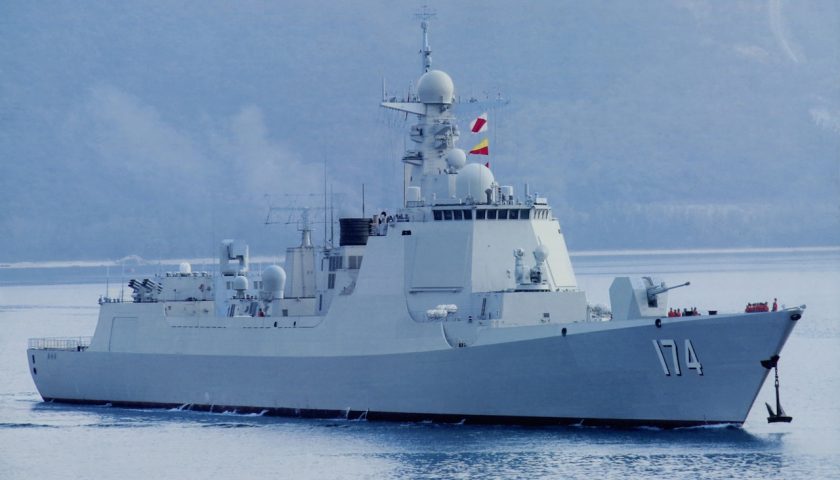With three times as many large combat ships entering service in the Chinese Navy each year, the US Navy is now betting on an asymmetrical balance of power based on its numerically and technologically superior naval aviation and submarine fleet.
In this section:
Two new Type 052D destroyers for the Chinese Navy
A few days ago, the shipyards in Dalian, in the northeast of the country, in the province of Liaoning, simultaneously launched 2 new Type 052D destroyers, the 27th and 28th units of this class designated within NATO under the code Luyang III, while five other hulls were observed at various levels of finish on this site.
As in previous years, there is little doubt that the year 2023 will see the arrival of 7 to 9 new destroyers within the Navy of the People's Liberation Army.
157 meters long for a displacement of 7.500 tonnes, these ships are both modern and very well armed, with 64 vertical silos accommodating HHQ-9 long-range surface-to-air missiles, YJ-18 cruise missiles and CY-5 anti-submarines, as well as a 130 mm gun, and two self-protection systems CIWS HQ-10 (equivalent to the American RAM) and Type 1130 (equivalent to the Phalanx).
Although they are less well equipped and armed than the Arleigh Burke Flight IIa and Flight III destroyers currently being manufactured across the Atlantic, they are nevertheless produced more than three times faster than the latter. In fact, within eight years, the Chinese fleet will field more large surface combatant units than the US Navy, and the gap will only widen beyond that.
The US Navy wants to increase production of Arleigh Burke destroyer
To respond to this major challenge, the US Navy has taken several measures to challenge, as effectively as possible, the evolution of this balance of power. It thus wants to increase production of Arleigh Burke to 2,5 units per year, and has ordered around twenty Constellation class heavy frigates.
Above all, the US Navy has created even closer ties with allied navies in the Pacific zone, such as Japan, Australia, South Korea, as well as by having convinced the Europeans to intensify their efforts and deployments in this theater.
However, the most significant decision, to anticipate this unfavorable balance of power, is not based on the extension of the fleet of surface combatant units, a trajectory probably doomed to failure given the industrial, economic and demographic potential. from Beijing. It is based, on the contrary, on the construction of an asymmetrical naval balance of power with the Chinese Navy.
This refusal to respond to the Chinese standoff is reflected in the preparation of the 2024 budget of the US Navy, which only provides a budget of $187 million for the development of the DDG(x) program to enter production following Arleigh Burke Flight III destroyers in the middle of the next decade.

The US Navy's three-point asymmetric response to the Chinese challenge
To do this, Washington relies on three capabilities in which the US Navy maintains an advantage not only technologically, but also numerically and operationally.
Creation of a vast fleet of robotic ships
The first of them is still in its infancy, and will be based on the creation of a large fleet of autonomous surface ships and submarines, acting for the benefit of American surface ships and submarines to extend their performance, detection means as well as firepower .

The rest of this article is for subscribers only
The Classic subscriptions provide access to
all articles without advertising, starting at € 1,99.
Newsletter subscription
Register for the Meta-Defense Newsletter to receive the
latest fashion articles daily or weekly


I remain perplexed about the so-called quality of the Chinese boats.
For comparison, the Chinese quality made in China by Chinese people in civilian life is simply catastrophic (not to be confused with Western made in China).
I don't see how, based on Russian architecture and Western industrial plunder, one can come to the conclusion that these boats are great……
I feel like I'm seeing the same ultra-positive assessment of Russian before Ukraine.
There are very objective criteria on which reflection can be based. For example, the Chinese ships which evolve in long mission in the Pacific or the Indian, often leave for 4 to 6 months without tug of support (contrary to the Russians) whereas they have very few accessible naval bases relay. Moreover, nothing indicates a particularly high incident rate during maneuvers and training sessions, which are very numerous.
In the air domain, we can base ourselves on the international exercises in which certain Chinese units participate. Thus, a few years ago, Thai JAS39 C/Ds were bent by Chinese J-10Cs during a joint exercise.
Finally, China is rather very discreet about the performance of its armaments, and what we learn comes mainly from international exercises, export customers or certain indiscretions of intelligence services, for example during congressional hearings.
The difference with Russia is that Moscow has never seriously considered a confrontation with NATO, while Beijing, like Washington, considers a Sino-American confrontation almost inevitable in the years to come. Moreover, the Pentagon has never changed its planning vis-à-vis Moscow, while all its planning since 2018 has been centered on Beijing.
Thank you for your reply 🙂
I activated comments precisely to allow subscribers to ask questions 😉
[…] […]